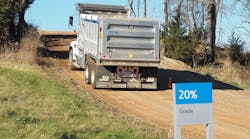MARSHALL, MI. Eaton showed off new low-speed technologies and announced broader availability for its advanced-function service and diagnostics tool yesterday at its proving grounds facility in Marshall, MI.
The low-speed maneuverability features — which allow for more precise, controlled incremental movements of heavy trucks — are optional on the power management company's UltraShift PLUS and Fuller Advantage automated manual transmissions. They're available at no additional charge and are "easily configurable" with Eaton's ServiceRanger 4 PC-based diagnostic and service tool, according to the company, and will be accessible in the Standard and Professional ServiceRanger packages by early 2016.
The new low-speed features are called Urge to Move and Blended Pedal. "This year, we really made a push to enhance our low-speed performance," said Evan Vijithakumara, product strategy manager for Eaton's heavy duty/vocational lineup. He added that the two features are "fundamentally different than what we've offered in the past targeted at low-speed maneuverability."
Urge to Move
This Eaton feature essentially can make a heavy truck with one of the applicable automated transmissions creep forward like a passenger car with automatic transmission would when the driver takes his or her foot off the brake pedal. It can make for better ease of use for the advanced driver, according to the company, but can be a particular help for less-experienced drivers and those "really anchored in that passenger car-style feel" — potentially a boon for fleets struggling with driver turnover and a limited pool of driver applicants.
"In Urge to Move, when you release the brake pedal, the transmission will — as quickly as it can, safely — ramp the clutch to a lock position. So it's automatically entering what we would call 'creep mode' in the past," said Vijithakumara.
"But there's a technical advantage," he added. "Because we are only starting to ramp that clutch when you release the service brake, there's no fighting the truck when you're on the brake pedal. When you're on that brake pedal, you can be assured that you're holding the truck and you're not having any untoward motion."
Blended Pedal
Vijithakumara said Blended Pedal allows a driver to manipulate the clutch in the automated manuals by positioning the accelerator. It may be a welcome addition especially for "that two-pedal driver who's moved to automation, but misses that clutch pedal and wants that manual-style control," he contended.
"The way it works is while you're going through the first portion of the pedal, we're able to hold the engine at idle and allow you to manipulate clutch slip. That allows you to move at speeds well below full lockup and gives you the ability to position [the truck] a half-inch, one inch, two inches at a time in forward and reverse, when enabled," he told reporters.
With Blended Pedal enabled, drivers can accelerate out of that super-slow maneuverability mode because Eaton added a "dead pedal" band: the driver simply throttles the engine speed above idle to return to a normal drive mode.
The feature comes in handy, according to Vijithakumara, in situations such as trying to precisely control the position of a mixer chute without increasing the rotation of the truck's drum. "We can do that with clutch slip. It's something that manual drivers have always enjoyed, but you lose when you start moving to automation; that's what we've been able to change with the introduction of this feature," he said.
ServiceRanger 4 expansion
The Blended Pedal and Urge to Move features can be "unlocked," so to speak, using Eaton's proprietary service and maintenance tool, ServiceRanger 4. The company is deploying the advanced configuration functionality of the tool to OEM dealerships, fleets and aftermarket repair facilities that have the ServiceRanger 4 Standard and Professional packages in early 2016.
"Within the ServiceRanger packages, we have a transmission shift mode configuration section that allows you to set any one of these features [Blended Pedal and Urge to Move] in the drive modes you're comfortable selecting. You can choose to turn on Blended Pedal in Manual or Urge to Move in Manual, for example," said Vijithakumara.
The additional capability is available at no charge for ServiceRanger 4 users, but customers that have only the tool's Basic package or don't use it will need to go to a dealership location, which may charge a fee to update trucks' transmission configurations.
"It really allows fleets to tailor their trucks individually, if they'd like to," pointed out Tony Truelove, global marketing communications manager at Eaton.
Features of ServiceRanger 4 include the abilities to:
● View active and inactive fault codes;
● Create and review service activity reports;
● Run specialized tests for difficult-to-determine issues;
● View "real-time" vehicle data parameter values;
● Update vehicle product software;
● View service info for Eaton products; and
● Check for automatic updates on products and service information.



